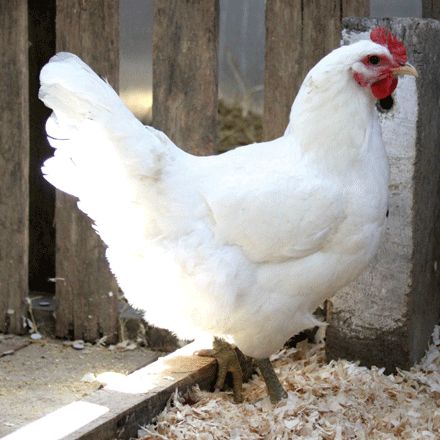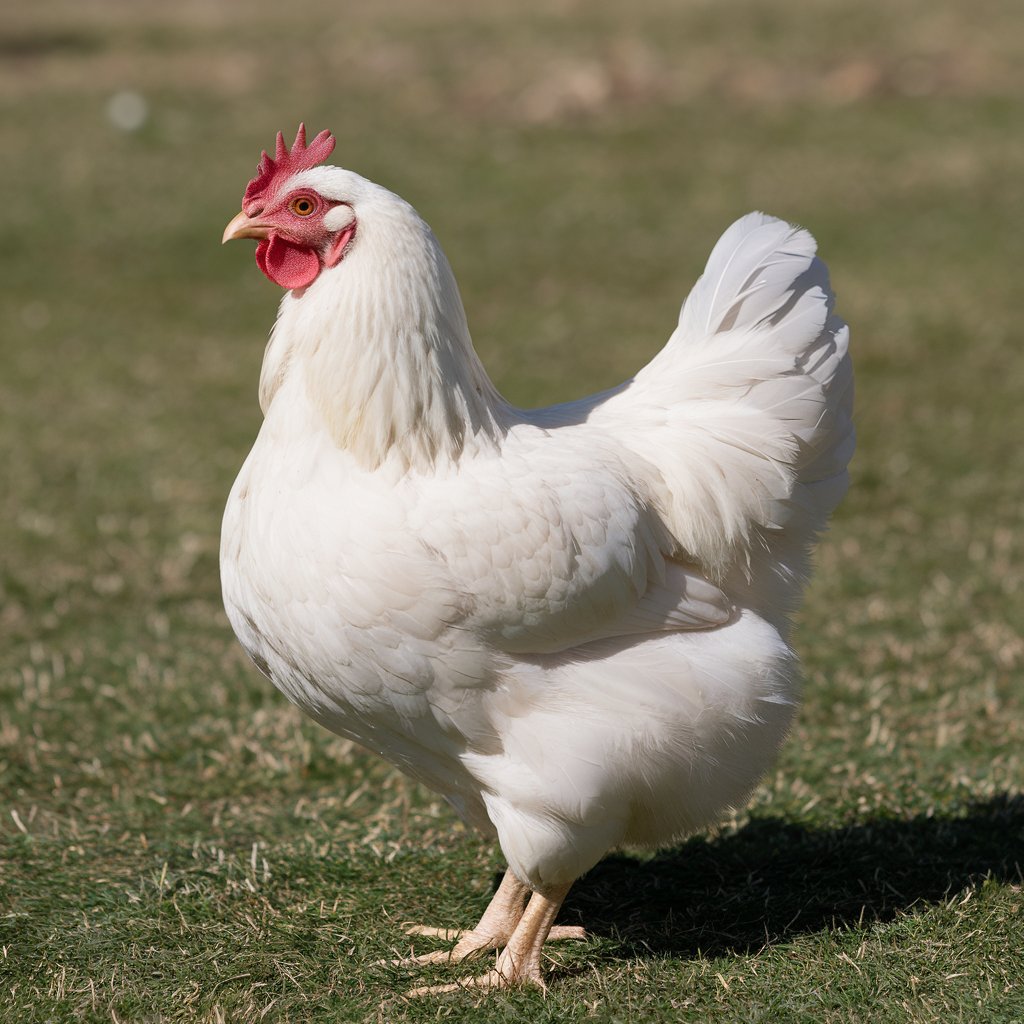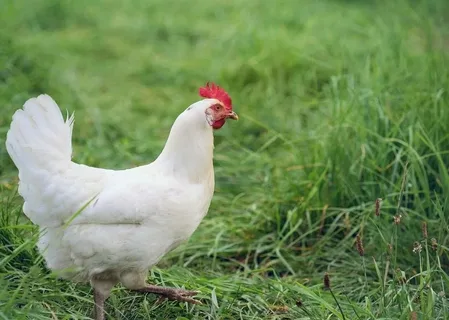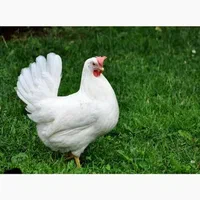The White Jersey Giant Chicken is among the most impressive poultry breeds available, known for its colossal size, docile nature, and versatility as both an egg layer and meat producer. Whether you’re raising them for backyard enjoyment or for practical farming purposes, the White Jersey Giant offers a unique combination of traits that make them stand out from other breeds. This breed’s consistent performance in both egg production and meat makes it a dual-purpose treasure for both hobbyists and commercial farmers alike.
If you’re considering adding these birds to your flock, read on to learn everything you need to know about the White Jersey Giant Chicken, from its rich history to practical care tips.
Here’s a table summarizing the key facts and figures about the White Jersey Giant Chicken:
| Feature | Details |
|---|---|
| Breed Name | White Jersey Giant Chicken |
| Origin | United States, developed in New Jersey |
| Size (Roosters) | 13-15 lbs (5.9-6.8 kg) |
| Size (Hens) | 11 lbs (5 kg) |
| Egg Size | Large to Extra-large |
| Egg Color | Brown |
| Egg Production | Approximately 250 eggs per year |
| Lifespan (Backyard) | 8 years (with proper care) |
| Lifespan (Commercial) | 2-3 years (meat production) |
| Growth Rate | Slow-growing, reaches full maturity in 9 months |
| Meat Production | Excellent quality, tender meat, slow maturing |
| Temperament | Calm, docile, good for beginners |
| Broodiness | Some hens may go broody, but not a dominant trait |
| Cold Tolerance | Excellent, thrives in cold weather |
| Heat Sensitivity | Can struggle with extreme heat, needs shade and ventilation |
| Housing Requirements | 6-8 sq. ft per bird in a coop, 30 sq. ft in an enclosed run |
| Hardiness | Hardy overall, disease-resistant |
| Breed Recognition | Recognized by the American Poultry Association (APA) in 1874 |
| Crossbreeding | Crossed with Langshans, Brahmas, Orpingtons, Javas |
Introduction: The White Jersey Giant Chicken at a Glance
The White Jersey Giant is often regarded as one of the largest chicken breeds in the world. Unlike many other chickens that are raised primarily for either eggs or meat, the White Jersey Giant excels in both categories. Originally developed in the United States as a meat bird with good egg-laying abilities, these chickens have proven to be hardy, low-maintenance, and productive over time. They have become an excellent choice for anyone seeking meat and egg production without compromising on the bird’s temperament.
While their size and productivity are major advantages, their calm and docile temperament makes them an appealing choice for small farms or backyard enthusiasts. Their resilience in colder climates, combined with their steady egg-laying and tasty meat, makes them a breed worth considering for both new and experienced poultry keepers.

The History of the White Jersey Giant Chicken
The Jersey Giant Chicken was originally developed in the state of New Jersey, USA, in the mid-1800s. The breed was a collaborative effort by two farmers, John and Thomas Black, who wanted to create a bird that would serve as both a meat bird and a reliable egg layer. They sought to combine the best traits of several large breeds, including the Langshan, Brahma, Orpington, and Javas. These breeds were selected for their size, egg production, and hardiness, which led to the development of the Jersey Giant.
The White Jersey Giant emerged as a variation of the original black Jersey Giant. While the black Jersey Giants were already becoming popular, some poultry enthusiasts wanted a bird with a lighter feather color, which led to the development of the white variety. This was also done to cater to the growing interest in white meat and eggs, which were perceived as cleaner or more appealing to certain markets.
By the early 1900s, the Jersey Giant had gained a solid reputation and was officially recognized by the American Poultry Association (APA) in 1874. The White Jersey Giant, like its black counterpart, has remained largely unchanged since its recognition and continues to be bred for its size, meat quality, and egg-laying abilities.
Is the White Jersey Giant a Heritage Breed?
Yes, the White Jersey Giant is considered a heritage breed. Heritage breeds are those that have been maintained without significant modification through selective breeding practices. These birds have adapted to traditional farming systems, where they were raised in natural environments without the use of commercial techniques such as artificial insemination or hormone treatments.
The Jersey Giant breed, in both its black and white forms, is considered a part of the heritage poultry breeds because of its historical significance and the fact that it has remained true to its original form for over a century. Unlike commercial hybrids bred for mass production, heritage breeds like the White Jersey Giant maintain their genetic diversity and are known for their hardiness, resilience, and longevity.
Preserving heritage breeds is essential for maintaining biodiversity in the agricultural world. By raising these birds, you are supporting the preservation of a species that was developed before industrial agriculture took over the poultry industry. Heritage birds like the White Jersey Giant are a testament to traditional farming methods and the importance of genetic diversity.

Distinctive Appearance of the White Jersey Giant Chicken
The White Jersey Giant is known for its impressive size, graceful appearance, and striking white feathers. They are the largest of the Jersey Giant varieties, making them a standout in any flock. Here’s a deeper look at their physical characteristics:
- Size: The White Jersey Giant is a large breed with roosters (males) typically weighing between 13 to 15 lbs (5.9-6.8 kg) and hens (females) averaging 11 lbs (5 kg). Their size is one of their most defining features, and it plays a significant role in their reputation as a dual-purpose breed. The larger frame allows for greater meat production, while still being able to lay a steady supply of eggs.
- Feathers and Plumage: The defining feature of the White Jersey Giant is its beautiful pure white feathers. Their feathers are soft, smooth, and dense, providing good insulation. These birds often appear strikingly clean, and their pure white coloration sets them apart from the black or blue varieties of Jersey Giants.
- Head and Face: The head of a White Jersey Giant is typically adorned with a large red comb that stands tall on top. The comb is upright and evenly serrated. The wattles and earlobes are also bright red, providing a vivid contrast against their white plumage. This coloration is especially noticeable and is one of the reasons Jersey Giants are such attractive birds.
- Body Shape: The White Jersey Giant has a deep, broad chest and a long, thick neck. Their body shape is powerful and well-suited to their role as a meat bird. The broad body ensures a good yield of high-quality meat, especially in the breast and thigh areas. Their legs are thick and sturdy, supporting their substantial weight.
- Legs and Feet: Like other large breeds, the White Jersey Giant has bare legs that help them stay clean and healthy. Their legs are strong and muscular, built to support their heavy bodies. The bare legs are typical of many dual-purpose chicken breeds, making them more resistant to feather mites and other health issues related to the feathers.
How Much Do White Jersey Giant Chickens Weigh?
When it comes to weight, the White Jersey Giant is truly an imposing bird. Here’s what you can expect:
- Roosters: The roosters (male chickens) of this breed can weigh between 13 and 15 lbs (5.9 to 6.8 kg). Their substantial weight makes them one of the largest breeds in the chicken world, and this is one of the reasons they are so highly valued for their meat. With such a large frame, they produce an ample quantity of tender, flavorful meat. They are slow growers, taking approximately 9 months to reach full maturity.
- Hens: The hens (female chickens) of the White Jersey Giant breed are slightly smaller but still impressively large, typically weighing 11 lbs (5 kg). Although they are not as heavy as the roosters, these hens still provide a decent amount of meat, which makes them a good choice for meat production as well. In addition to their size, they are also reliable egg layers, producing large, brown eggs consistently.
Their weight and size are key factors in their dual-purpose status. These birds are not only suited for meat production but also have enough egg-laying capacity to make them valuable for farm operations.

Life Expectancy of White Jersey Giant Chickens
The life expectancy of the White Jersey Giant varies depending on the conditions in which they are raised. Here’s what you can expect:
- Backyard Flock: If raised in a backyard flock where they are given proper care, the White Jersey Giant can live up to 8 years or longer. When raised in ideal conditions with proper feeding, healthcare, and protection from predators, these birds can have a long and productive life. They are relatively disease-resistant and hardy, making them suitable for a variety of climates and environments.
- Commercial Settings: In commercial farming settings where these birds are primarily raised for meat production, their lifespan is typically shorter. They are often harvested at around 9 months of age when they reach their optimal weight. While their lifespan is reduced in these environments, they still provide high-quality meat, making them a favorite among poultry farmers.
Their longevity in backyard settings makes them valuable pets or utility birds that will continue to produce eggs and meat for several years.
Egg Production of the White Jersey Giant Chicken
One of the standout features of the White Jersey Giant is its ability to consistently produce large and extra-large eggs. Here’s what to expect from their egg-laying abilities:
- Egg Size: The eggs laid by the White Jersey Giant are typically large to extra-large in size. The eggs are often brown in color, although some may have a lighter tint. Their large size means they have thicker shells, making them less likely to break during handling. This makes them a favorite for both personal use and sale.
- Egg Production Rate: On average, a White Jersey Giant hen will lay around 250 eggs per year. While they don’t produce eggs at the same high rate as some specialized egg-laying breeds, they are still consistent layers. Their steady egg production is ideal for those looking for reliable egg output alongside high-quality meat production.
White Jersey Giants are known for laying eggs in a regular cycle, with some hens laying well into the winter months. They are relatively hardy in cold climates and will continue to lay eggs even in less-than-ideal weather conditions.

Breeding White Jersey Giant Chickens
Breeding White Jersey Giant Chickens is relatively straightforward, thanks to their strong genetics and natural reproductive instincts. Here’s what you need to know about breeding these birds:
- Selecting Breeding Stock: When breeding Jersey Giants, it is important to choose healthy birds that conform to the breed standard. Look for large, robust birds with proper feathering, a good temperament, and a strong build. Proper breeding stock ensures that the next generation will inherit the breed’s desirable traits, including their size and egg-laying abilities.
- Fertility: The fertility of the White Jersey Giant is generally high, and hens can successfully produce a good number of chicks when mated with healthy roosters. Their natural breeding abilities make them a reliable choice for those looking to expand their flock without relying on artificial insemination or other modern breeding techniques.
- Incubation: Once the eggs are laid, incubation takes about 21 days. If you’re incubating eggs yourself, make sure to maintain a stable temperature and humidity level to ensure the best hatch rate. Some hens, particularly those with strong maternal instincts, will incubate the eggs themselves, but keep an eye on their size to avoid crushing the eggs.
Are White Jersey Giant Chickens Broody?
The White Jersey Giant breed can exhibit broody behavior, though it is not as common as with smaller breeds. Broodiness is a trait where hens want to sit on their eggs to incubate them until they hatch.
- Broody Traits: While Jersey Giant hens are not as frequently broody as some bantams or other more maternal breeds, some hens do have strong maternal instincts. If you have a broody hen, it’s important to provide her with a safe, quiet space to sit on her eggs. However, due to their large size, there is always the risk of accidentally crushing the eggs.
- Managing Broodiness: If broodiness isn’t something you want to deal with, simply remove any eggs laid by a broody hen. This will prevent them from sitting on the eggs and eventually breaking them. Alternatively, you can allow a broody hen to incubate the eggs and hatch chicks naturally.

Hardiness of the White Jersey Giant Chicken
The White Jersey Giant is well-known for its hardiness and resilience, making it an ideal choice for those who live in regions with extreme weather conditions.
- Cold Tolerance: The White Jersey Giant excels in cold environments, thanks to its thick plumage and large body size, which provide excellent insulation. They are well-suited for winter months, where their feathers help keep them warm even in freezing temperatures.
- Heat Sensitivity: While the breed is cold-hardy, they may struggle with extreme heat. During hot weather, they may need access to shade, cool water, and ventilation to stay comfortable. Their size means they can be more vulnerable to heat stress if not properly managed.
Overall, the White Jersey Giant is a hardy breed capable of thriving in various climates, though extra care may be needed in warmer regions.
Is the White Jersey Giant Chicken Right for You?
The White Jersey Giant is a fantastic choice for anyone seeking a reliable dual-purpose chicken breed. These birds are ideal for both meat production and egg-laying, with an easy-going temperament that makes them suitable for beginners and experienced poultry owners alike.
If you live in a cold climate or a region that experiences harsh winters, the White Jersey Giant’s hardiness will be a major advantage. Similarly, if you’re looking for large eggs and high-quality meat without needing a separate flock for each, this breed is the perfect choice.
Pros:
Large meat yield
- Reliable egg production
- Calm and docile temperament
- Cold-hardy and resilient
Cons:
- Slow growth rate
- Lower egg production compared to specialized egg layers
If you’re prepared to give them the space and proper care they need, the White Jersey Giant will reward you with its impressive size, consistent egg production, and delectable meat.

FAQs
What makes the White Jersey Giant chicken unique?
The White Jersey Giant stands out for its size, dual-purpose nature, and gentle temperament. It excels in both meat production and egg-laying while being calm and easy to handle.
How big do White Jersey Giant chickens get?
White Jersey Giants are large birds, with roosters weighing 13-15 lbs and hens around 11 lbs, making them excellent for both meat and egg production.
How long do White Jersey Giant chickens live?
These chickens typically live 8 years in backyard settings, but their lifespan is shorter in commercial environments, usually around 2-3 years.
Are White Jersey Giant chickens good for beginners?
Yes, they are ideal for beginners due to their docile nature, resilience, and ease of care, making them suitable for small farms or novice chicken keepers.
What is the egg production like with White Jersey Giant chickens?
White Jersey Giants lay about 250 large to extra-large brown eggs yearly, providing reliable production even though they aren’t the highest producers.
Are White Jersey Giant chickens good for meat production?
Yes, they are bred for meat, offering tender, flavorful meat due to their large size, and are especially favored for high-quality, natural chicken meat.
Do White Jersey Giant chickens go broody?
While not frequent, White Jersey Giant hens can go broody and attempt to incubate eggs, though their size means care is needed to prevent crushing the eggs.
How cold-hardy are White Jersey Giant chickens?
These chickens are highly cold-hardy thanks to their large size and thick feathers, making them well-suited for cold climates with minimal care.
What are the housing requirements for White Jersey Giant chickens?
White Jersey Giants need ample space—6-8 square feet per bird in the coop and 30 square feet in the run—to ensure they can move comfortably and avoid stress.
Do White Jersey Giant chickens make a lot of noise?
Roosters can be vocal with loud crowing, but hens are typically quiet, making them a good choice for quieter flocks if roosters are kept separate.
What color are the eggs laid by White Jersey Giant chickens?
The eggs laid by White Jersey Giants are brown, typically large to extra-large, with thick shells that make them highly sought after for cooking and baking.
How big are the eggs of White Jersey Giant chickens?
Their eggs are large to extra-large, making them ideal for cooking and baking, and they’re among the largest produced by chicken breeds.
Do White Jersey Giant hens lay eggs consistently throughout the year?
Yes, they consistently lay about 250 eggs per year, even during colder months, as long as they are kept in a well-maintained environment.
Are the eggs of White Jersey Giant chickens known for being of high quality?
Yes, their eggs are known for being high quality, with a rich taste, thick shells, and large size, making them popular among consumers.
Are the eggs of White Jersey Giant chickens good for hatching?
Yes, their eggs are fertile and suitable for hatching, although care must be taken during incubation to avoid crushing due to the hens’ large size.
How often do White Jersey Giant hens lay eggs?
White Jersey Giants lay consistently, with hens producing around 250 eggs annually, or about 5-6 eggs per week during their laying season.
What breed is the White Jersey Giant chicken?
The White Jersey Giant is a large, dual-purpose breed primarily raised for meat production, developed from the Black Giants and known for its size and quality.
How many eggs do White Jersey Giants lay?
White Jersey Giants typically lay 2+ extra-large brown eggs per week, with annual production reaching 150-200 eggs in their first year.
What are Jersey Giant chickens used for?
Jersey Giants are mainly used for meat production due to their large frame, producing excellent meat for roasting and other dishes, ideal for family meals.
At what age do Jersey Giants start laying?
Jersey Giants can be slow to start laying, with some hens beginning as late as 8-10 months, though others may start as early as 5 months.
What is the lifespan of a Jersey Giant?
Jersey Giants live an average of 5-8 years, thriving with proper care and maintaining productivity throughout their lifespan.
How fast do Jersey Giant chickens grow?
Jersey Giants take about 8-9 months to reach full size, growing slowly but steadily to achieve their large frame, which is ideal for meat production.
Are Jersey Giant chickens aggressive?
Jersey Giants are known for their calm and docile temperament, with minimal aggression, making them a peaceful addition to any flock.
What is the difference between red broiler and Jersey Giant?
The Jersey Giant grows slower but has a larger frame and superior flavor compared to the faster-growing Red Broiler, which excels in free-range environments.
At what age do Jersey Giants stop growing?
Jersey Giants typically reach full growth by 9 months, maintaining good health due to their slower growth pattern compared to other breeds.
Are Jersey Giants rare?
While not extremely rare, Jersey Giants are considered a less common breed, valued for their impressive size and dual-purpose qualities.
Do Jersey Giants grow slow?
Yes, Jersey Giants grow slowly, allowing for better flavor development, reaching sizes 30% larger than many other heavy breeds.
How to tell if a Jersey Giant is a rooster?
Rooster Jersey Giants have more pronounced combs and wattles compared to hens, which have balanced, well-rounded bodies with smoother feathers.
Conclusion
The White Jersey Giant Chicken is an extraordinary breed that continues to stand out in the poultry world for its impressive size, calm demeanor, and versatility. Whether you’re raising them for meat, eggs, or both, they are a valuable asset to any farm or backyard flock.
Their large size, consistent egg production, and hardy nature make them an ideal breed for many different farming environments. By choosing the White Jersey Giant, you’re adding a hardworking, docile, and resilient bird to your flock, one that will continue to provide for your family for many years to come.
Read more knowledgeable blogs on Flowy Magazine

James Clair is a passionate writer and researcher with a deep fascination for animal behavior and its intricate connection to human life. With a background in [relevant field of study, e.g., zoology, psychology, ethology], James has spent years studying the natural world, focusing on how animals’ actions and instincts impact human emotions, behavior, and society.
His expertise in [specific topics or regions of focus, e.g., canine psychology, animal communication, wildlife conservation] has led to numerous published works and collaborations with renowned researchers and institutions. Through his work at Flawy Magazine, James aims to bridge the gap between scientific research and public understanding, offering insightful, accessible articles that explore the complex relationship between humans and animals.
When he’s not writing, James enjoys [personal hobbies or interests, e.g., hiking in nature, volunteering at animal shelters, photography] and is an advocate for [cause or charity related to animals or conservation]. His mission is to inspire readers to see animals not just as companions or creatures of the wild, but as beings whose behavior holds valuable lessons for us all.









